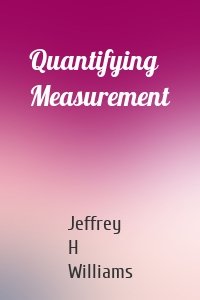Jeffrey H Williams
4 кн.
Quantifying Measurement
Measurements and experiments are made each and every day, in fields as disparate as particle physics, chemistry, economics and medicine, but have you ever wondered why it is that a particular experiment has been designed to be the way it is. Indeed, how do you design an experiment to measure something whose value is unknown, and what should your considerations be on deciding whether an experiment has yielded the sought after, or indeed any useful result? These are old questions, and they are the...
| Автор | Jeffrey H Williams |
Crystal Engineering
There are more than 20 million chemicals in the literature, with new materials being synthesized each week. Most of these molecules are stable, and the 3-dimensional arrangement of the atoms in the molecules, in the various solids may be determined by routine x-ray crystallography. When this is done, it is found that this vast range of molecules, with varying sizes and shapes can be accommodated by only a handful of solid structures. This limited number of architectures for the packing of...
| Автор | Jeffrey H Williams |
Defining and Measuring Nature (Seco...
Measurement forms an essential part of our view of the world. Our world is measured and calibrated, and we are all subject to the tyranny of these numbers. In this updated and extended edition, Jeffrey Huw Williams outlines the history of measurement; particularly of the International System of units (SI). Since the previous edition, the base units of the SI have been redefined; realizing a 150-year-old dream for a measurement system based on unchanging, fundamental quantities of nature. This...
| Автор | Jeffrey H Williams |
Order from Force
The present theme concerns the forces of nature, and what investigations of these forces can tell us about the world we see about us. The story of these forces is long and complex, and contains many episodes that are not atypical of the bulk of scientific research, which could have achieved greater acclaim 'if only…'. The intention of this book is to introduce ideas of how the visible world, and those parts of it that we cannot observe, either because they are too small or too large...
| Автор | Jeffrey H Williams |





